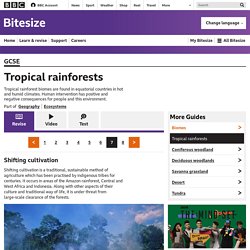

Bitesize - GCSE Geography - Tropical rainforests - Revision 7. Shifting cultivation is a traditional, sustainable method of agriculture which has been practised by indigenous tribes for centuries.

Is Brazil now in control of deforestation in the Amazon? 1Since 2005, the total area deforested annually in the Amazon diminishes almost every year and, in 2014, it was only 20% of what it was in 2004.

Does this mean that Brazil finally controls deforestation? What are the mechanisms which have made this achievement possible? What are the consequences on climate change issues? 2To answer these questions, one has to dig into the complexity of deforestation as a multi-dimension phenomenon and to deal with economic (who deforests and why) as well as social (access to land, land conflicts), environmental (impacts on climate, biodiversity) and geopolitical issues (the role of Brazil in global negotiations on climate change and greenhouse gases emissions). The size of the Amazon rainforest adds to this complexity since the factors at play are not the same across such a vast area. Slash and Burn Agriculture Explanation. Iceland Is Growing New Forests for the First Time in 1,000 Years.
These Farmers Slash and Burn Forests—But in a Good Way. In the dark, unfurnished room where Chaiprasert Phokha sits, in a house on stilts, a sunbeam falls through the pane-less window and fills a glass jar with amber light.

Phokha leans his wiry body into the light and pops the vacuum-sealed lid off the jar. With an encouraging nod, he passes it to me. The sweet aroma of rainforest blossoms fills my nostrils. “We’ve harvested 3,000 jars (1,500 lbs) of wild honey this year,” Phokha says. Providing an Alternative to Slash and Burn Agriculture – Resilience. Slash and burn. Slash and burn (a specific practice that may be part of shifting cultivation or swidden-fallow agriculture) is an agricultural procedure widely used in forested areas.

Although it was practised historically in temperate regions, where it was termed assarting, it is most widely associated with tropical agriculture today. Slash and burn is a specific functional element of certain farming practices, often shifting cultivation systems. In some cases such as parts of Madagascar, slash and burn may have no cyclical aspects (e.g some slash and burn activities can render soils incapable of further yields for generations), or may be practiced on its own as a single cycle farming activity with no follow on cropping cycle. Slash-and-burn 'improves tropical forest biodiversity' [MEXICO CITY] Slash-and-burn agricultural practices, banned by governments because of the risk of uncontrolled fires, provide better growing conditions for valuable new trees than more modern methods of forest clearance, a study suggests.

Starting in 1996, researchers cleared 24 half-hectare areas of tropical forest in Quintana Roo state, in southern Mexico, using three methods: clear-felling, where most of the trees are cut down; bulldozing; and slash-and-burn, a practice common among smallholders, in which trees are felled, left to dry and then burned, to prepare the land for agriculture. 3 Hidden Dangers of Slash-and-Burn Farming Techniques. Slash and Burn farming techniques are known for their destructive qualities, but rainforest conservationists are finding more dangers that threaten the health of this fragile environment.

In Indonesia, some farming takes place in areas that have been cleared by slash and burn practices. This technique involves cutting trees and vegetation and leaving it on the ground as it falls. After it dries out, the area is set ablaze. Farmers then plant crops in the soil that’s left behind. After a few years, this soil is depleted of it’s essential nutrients and farmers must move on. What is slash and burn farming? Slash and burn farming is a form of shifting agriculture where the natural vegetation is cut down and burned as a method of clearing the land for cultivation, and then, when the plot becomes infertile, the farmer moves to a new fresh plot and does the same again.

This process is repeated over and over. Slashed and burned slope. Photo by Antony Melville 2007. Maybe about 250 million (they are not easy to count) are forced to eke out a living like that on some of the world's poorest soils. By slashing and then burning tropical forest, these landless farmers can usually sustain themselves for only 2 consecutive years on the same patch of soil. Deforestation Facts, Deforestation Information, Effects of Deforestation. Modern-Day Plague Deforestation is clearing Earth's forests on a massive scale, often resulting in damage to the quality of the land.

Forests still cover about 30 percent of the world’s land area, but swaths the size of Panama are lost each and every year. The world’s rain forests could completely vanish in a hundred years at the current rate of deforestation. Forests are cut down for many reasons, but most of them are related to money or to people’s need to provide for their families.The biggest driver of deforestation is agriculture. Farmers cut forests to provide more room for planting crops or grazing livestock. Logging operations, which provide the world’s wood and paper products, also cut countless trees each year.
Not all deforestation is intentional. Deforestation has many negative effects on the environment. Deforestation also drives climate change. Trees also play a critical role in absorbing the greenhouse gases that fuel global warming. National Geographic: Eye in the Sky. The statistics paint a grim picture.

According to the World Resources Institute, more than 80 percent of the Earth’s natural forests already have been destroyed. Up to 90 percent of West Africa’s coastal rain forests have disappeared since 1900. Deforestation: Facts, Causes & Effects. Deforestation is the permanent destruction of forests in order to make the land available for other uses.

An estimated 18 million acres (7.3 million hectares) of forest, which is roughly the size of the country of Panama, are lost each year, according to the United Nations' Food and Agriculture Organization (FAO). Some other statistics: About half of the world's tropical forests have been cleared (FAO) Forests currently cover about 30 percent of the world’s land mass (National Geographic) Forest loss contributes between 6 percent and 12 percent of annual global carbon dioxide emissions (Nature Geoscience) About 36 football fields worth of trees lost every minute (World Wildlife Fund (WWF)) Deforestation occurs around the world, though tropical rainforests are particularly targeted. NASA predicts that if current deforestation levels proceed, the world's rainforests may be completely in as little as 100 years. Error loading player: No playable sources found Weather vs.
Local and Global Effects of Deforestation in the Amazon Rain Forest - National Geographic Society. 1. Activate students’ prior knowledge about the local and global environmental effects of deforestation. Introduce the activity with a discussion about students’ local area and the organisms that live there. Ask students to brainstorm what roles trees might play in the forest. Then have students brainstorm consequences to the plants and animals that inhabit the local ecosystem if all the trees were removed. Environment vs Development - Amazon: Truth and Myth - BBC. Amazon Rain Forest, Deforestation, Forest Conservation - National Geographic Magazine. Last of the Amazon In the time it takes to read this article, an area of Brazil's rain forest larger than 200 football fields will have been destroyed.
Twenty First Century Renewable Energy : Documentary on the Energy of the Future (Full Documentary) The truth about “slash-and-burn” agriculture – Thousand word essays on food security and sustainability. Article highlights Slash-and-burn agriculture (SBA) has been carried out by rural communities for hundreds of years,For a while now researchers have found that instead of being harmful, it generally: Encourages biodiversityDoesn’t appear to play a significant role in soil degradationDoesn’t lead to significant deforestation, (after cultivation the field is left to regenerate)Doesn’t lead to significant carbon emissions, and certainly much less than permanent cropping systemsProvides food security to otherwise vulnerable communities.Nevertheless, its bad reputation remains,Governments are introducing policies to ban SBA as part of deforestation and climate change initiatives,This is displacing rural communities who otherwise have no way of accessing food and livelihoods,Plus, intensified cropping systems are bad for the environment,This is leading to further poverty and food insecurity for the most vulnerable communities.